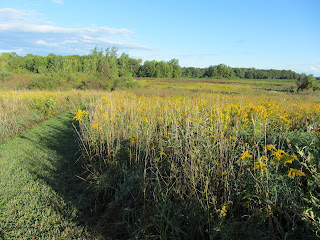Saturday was a good day at Forest Hill for a hike with my dog, Remi. The early morning weather was mostly sunny with a temperature of 44 degrees and no wind. At the crest of the hill, I gazed to the west at the early fall foliage and decided it was time to pay attention to color changes of vegetation as green chlorophyll begins to disappear. I descended the hill, hiked past Mallard Marsh into Bobolink Meadow where I scared up four hen pheasants and one rooster. Near the entrance to North Woods, I noticed that all the leaves on a Green Ash tree had turned yellow and some of the leaves of Silver Maple were turning red. I walked west through the woods, exited and continued around Succession Field where I saw some Rose hips and Nannyberry fruit. Also, I noticed the unusual fruit of the Musclewood tree consisting of green chains of nutlets and bracts hanging from the branches. I entered South Woods where I noticed hickory nutshells and hulls on the boardwalk left by the squirrels. Hiking along the edge of Swanson Swamp, I saw that the Witch Hazel Trees had clusters of seed capsules. When mature, these capsules will snap open and throw the seeds up to 20 feet from the tree. Exiting the woods, I continued toward Artist Overlook where I spotted a Wooly Bear Caterpillar crawling on the path. This amazing creature will overwinter in this stage and turn into a Tiger Isabella Moth next spring. I turned north back toward Willow Wallow where I paused to observe a small patch of a new plant, called Northern Willow herb. A tea made from the entire flowering plant was used to treat colds, fever, anorexia, indigestion, gastric troubles and internal bleeding. The fresh plant, often used as an expectorant and analgesic, made it useful in the treatment of cold and flu symptoms. I kept going along the edge of the pond where I scared up five Mallard ducks. Next, I climbed up the east side of Reflection Hill, walked around and descended the south side heading for Brady Cemetery. I came to the cemetery where I counted a dozen Canada Geese standing in the neighbor’s plowed field. I continued on the trail through Native Grassland past Grebe Pond and headed north toward the barn. Arriving at the barn, I spotted some Foxtail grass. Foxtails seeds (awns) can cause problems for pets. They can easily attach to the animal and because of their shape can penetrate deep into the body. They have the potential to cause serious infection and irritation. I passed the Classroom Building where I spotted some Smartweed along the east side. Finally, we entered the van for our journey home.
Clues of autumn are all around
Colorful leaves are raining down
Yellow goldenrod fills my view
Meadow’s changing color and hue
Aster blossoms are a lovely sight
They dot the field in shades of white
Birds gather and soon depart
Their journey south is about to start
Chorus of crickets is a welcome sound
They hide well, they can’t be found
Vernal ponds are empty once more
Spring rains will help them restore
Squirrels are busy doing their thing
They gather food to last till spring
Mighty sun continues to shine
Daylight hours rapidly decline
Lots of nature to remember
As I bid farewell to September
D. DeGraaf




